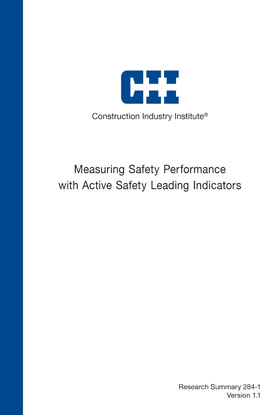
Measuring Safety Performance with Active Safety Leading Indicators, Version 1.1
Despite reductions in injury rates in the past few decades, many firms with world-class safety records have been frustrated by the inability to make step-change improvements in safety in recent years. Efforts to reduce injury rates by simply monitoring classic measures such as the Occupational Safety and Health Administration (OSHA) Total Recordable Injury Rate (TRIR) and the Experience Modification Rate (EMR) have not achieved the desired step-change improvement. Many safety professionals believe that the careful selection, measurement, and response to leading indicators of safety performance will yield significant improvements. CII established Research Team (RT) 284, Leading Indicators for Safety, to investigate the potential of these critical project metrics.
Leading indicators are measures of attitudes, behaviors, practices, or conditions that influence construction safety performance. RT 284 divides leading indicators into two groups, namely passive and active. Passive leading indicators are the safety strategies that should be implemented before the construction phase begins to set the project up for success. Typically, these practices are not adjusted once the project begins (e.g., contractual language and staffing) but serve as predictors of safety performance during construction. Alternatively, active leading indicators are safety-related practices or observations that can be measured during the construction phase, and that can trigger positive responses. Active leading indicators can be measured and adjusted as the project progresses to dynamically monitor and improve safety performance. RT 284 considers this difference between passive and active leading indicators—a distinction it made during the planning phase of the research process—as an important contribution to industry safety. The research team believes that implementation of active safety leading indicators opens a whole new approach to measuring safety performance on a project.
In order to independently examine both passive and active leading indicators, the research team divided the research effort into two phases. In the first phase, the team identified and defined over 100 safety strategies as potential passive leading indicators. To evaluate which of these passive leading indicators best predicted safety performance, the team conducted interviews with management and safety professionals who had familiarity with 57 ongoing or recently completed major projects. Responses to the interview questions related to a project’s use of the identified passive leading indicators were statistically compared to the project TRIR. From this comparison, 10 significant passive leading indicators showed a strong negative correlation with injury and illness rates. That is, the injury rates declined as more passive leading indicator practices were implemented. In fact, a statistical analysis of these data indicates that, in general, project recordable injuries were reduced by 0.85 per 200,000 worker hours for every two of the passive leading indicators that were implemented.
The second phase of the research focused on identifying active leading indicators that were extracted from three data sources. First, the research team established three subcommittees to identify, define, and evaluate active leading indicators specific to owners, contractors, and vendors, based on the experience and expertise of the team members. Second, the team conducted detailed case studies at 19 ongoing construction sites in an attempt to identify active leading indicators that were already being employed. These case studies involved data collection through site visits and project management interviews. Finally, the research included a detailed review of the safety performance of 14 award-winning projects identified from CII member organizations. The research activities in the second phase yielded 22 high-potential active leading indicators that have proven to be successful on past projects completed by industry leaders.
To help organizations implement active leading indicators, the research team created Implementation Resource (IR) 284-2, Implementing Active Leading Indicators. This resource explains that, when organizations select leading indicators for implementation, they should evaluate their current safety program, select leading indicators that complement existing strategies, and carefully add new leading indicators that integrate well into the organizational culture. It is important to recognize that leading indicator data collection must be built upon a comprehensive safety management program, which must begins with the full adoption of the CII Zero Accidents Techniques, including aggressive and visible senior management leadership that fosters employee involvement and ownership.
{^widget|(widget_displayname)WatermarkImage|(name)WatermarkImage|(image)%7e%2fCII%2fmedia%2fPublications%2f284_1Figure2.PNG%3fext%3d.png|(width)|(height)^}


